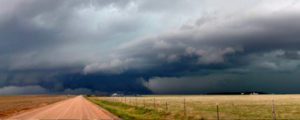Storms are major summer events, especially when you’re a kid. When a big system rolls in, the experience can range anywhere from exciting to terrifying.
Try some of these easy weather projects at home to help your child understand how these systems work and what creates them. While they need to be taken seriously, there is nothing like a little science and concrete knowledge to remove the mystery and, hopefully, some of the terror out of these powerful storms.
What causes a thunderstorm?
When a mass of cool air meets a mass of warm, moist air, things start moving around. Warm, moist air rushes upward and starts feeding a thunderhead. As the atmosphere becomes unstable, we start seeing thunder and lightning, and if the updraft becomes more powerful, it creates a spinning column of air known as a tornado.
In the summer, the U.S. sees 100,000 thunderstorms a year, and 10 percent turn severe, according to the National Weather Service.
This can be difficult for a child to visualize and wrap their head around. The following easy experiments simulate certain elements of the storm and can make these big concepts easier to comprehend.
Simulate air currents in the kitchen sink
Here’s a simple visual that shows how warm air rises and cool air sinks.
Several hours before the experiment, fill a pitcher with warm water, and add 2 to 3 drops of blue food coloring. Pour the blue water into an ice cube tray and freeze.
Once your blue cubes are frozen, fill a clear, shallow container with hot water and place the cubes on one side of the container. Then add couple of drops of red food coloring on the opposite end. As the cubes melt, watch the blue water hover at the bottom of the sink while the red hangs out at the top. Eventually, the colors will dilute and you’ll get a sink full of purple water.
It’s an illustration of what happens in a thunderstorm. As the warm air flows upward, it forms clouds and eventually releases moisture. As the warm air mixes with the cool, the storm eventually loses its “fuel” and breaks up.
“Lightning” in the dark
The best way to wrap the mind around how lightning forms is to make some static electricity of your own. Be sure to choose a day that is coolish (no more than 75 degrees) and has low humidity.
Blow up a balloon, grab a metal spoon and head into a darkened room. Rub the balloon on your hair. Then take the balloon, and touch the metal spoon to it. You should see a little flash of light! You may even hear a little snap.
Positive and negative charges of static electricity build up in the clouds. When there’s enough of it built up, a giant spark forms, and what you see and hear is lightning and thunder. Most lightning stays in the cloud, but sometimes it forms because there’s a charge buildup on the ground, and the spark forms between the top of the cloud and the ground. Lightning can reach 50,000 degrees Fahrenheit, which is hotter than the surface of the sun! That’s why it’s so important to stay inside when a storm is brewing, even if it isn’t raining yet.
Tornado in a jar
Depending on where you live, your kids may be used to hearing the sound of sirens blaring to indicate it’s time to take cover in the basement. To ease anxiety, create a tornado in a jar. It can be a hands-on but simple activity to help explain what makes a tornado take shape. For a kid-friendly explanation of how tornadoes form, check out this brief animated video created by the folks who brought you TED Talks.
What you’ll need is a jar with a screw-on lid. Fill it nearly full with water. Add a spoonful of distilled, white vinegar, a few pumps (or squirts) of liquid soap, and then tighten the lid. Shake the jar vigorously and watch the “funnel” cloud whirl round and round!
Learning is kind of like stacking blocks on top of one another. The more things your child can learn and discover, the easier it is to grasp abstract lessons at school. Home experiments and enriched activities, such as the after-school programs and summer camps offered by Bricks 4 Kidz, can lay a great foundation for learning.

